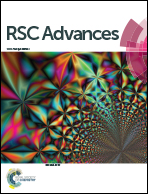A F-ion assisted preparation route to improve the photodegradation performance of a TiO2@rGO system-how to efficiently utilize the photogenerated electrons in the target organic pollutants†
Abstract
A comparison of the work function of reduced graphene oxide (rGO) and the conduction band position of TiO2 reveals that the density of TiO2 particles grown on rGO could affect the photodegradation efficiency of a TiO2@rGO heterojunction. Herein, with the introduction of F-ions into the preparation route, F-doped shaped TiO2 nanocrystals are densely and uniformly decorated on rGO sheets via the ice bath hydrolyzation method. Thus, more dye molecules are adsorbed on the surface of TiO2 and the photogenerated electrons in the excited dye molecules could be efficiently utilized to improve the overall photodegradation efficiency. The as-prepared F-doped TiO2@rGO heterojunction showed extremely high photocatalytic efficiency under UV-vis light irradiation compared with that of the commercial P25 and the mixture of F-TiO2 and rGO. It is proved that the ice bath hydrolyzation preparation route is crucial to improve the photodegradation efficiency of the final product since the pure TiO2@rGO heterojunction is also much more efficient than the mixture of F-TiO2 and rGO. The present work provides new insights into efficiently utilizing the photogenerated electrons in the target organic pollutants.


 Please wait while we load your content...
Please wait while we load your content...